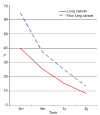Survival post surgery for malignant pericardial effusion
- PMID: 24765299
- PMCID: PMC3981241
- DOI: 10.4081/cp.2011.e38
Survival post surgery for malignant pericardial effusion
Abstract
The study reviews the survival of patients with malignant pericardial effusion treated with a subxiphoid pericardial window. The medical records of 60 consecutive patients diagnosed with a malignant pericardial effusion and treated with a subxiphoid pericardial window between 1994 and 2008 were reviewed. 72% had lung cancer. Overall 30-day mortality was 31%. Survival rates at 3 months, 6 months, 1 year, and 2 years were 45%, 28%, 17%, and 9%, respectively. Overall median survival was 2.6 months. Patients with malignant pericardial effusion, especially those with primary lung cancer have poor survival rates. In advanced malignancy, the subxiphoid pericardial window procedure provides only short-term palliation of symptoms, and has no effect on long-term survival. The use of any surgical procedure in patients with malignant advanced pericardial effusion should be considered along with non-surgical options on a case-by-case basis depending on symptoms, general status, and expected survival.
Keywords: malignant disease; pericardial effusion; subxiphoid window..
Conflict of interest statement
Conflict of interest: the authors report no conflicts of interest.
Figures
Similar articles
-
Mid-Term Efficacy of Subxiphoid Versus Transpleural Pericardial Window for Pericardial Effusion.J Surg Res. 2020 Aug;252:9-15. doi: 10.1016/j.jss.2020.01.014. Epub 2020 Mar 23. J Surg Res. 2020. PMID: 32213328
-
Surgical management of pericardial effusion in patients with malignancies. Comparison of subxiphoid window versus pericardiectomy.Cancer. 1991 Jan 1;67(1):76-80. doi: 10.1002/1097-0142(19910101)67:1<76::aid-cncr2820670115>3.0.co;2-6. Cancer. 1991. PMID: 1702345
-
Risk factors affecting the survival of patients with pericardial effusion submitted to subxiphoid pericardiostomy.Chest. 2003 Jul;124(1):242-6. doi: 10.1378/chest.124.1.242. Chest. 2003. PMID: 12853529
-
Pericardial effusion: subxiphoid pericardiostomy versus percutaneous catheter drainage.Ann Thorac Surg. 1999 Feb;67(2):437-40. doi: 10.1016/s0003-4975(98)01192-8. Ann Thorac Surg. 1999. PMID: 10197666 Review.
-
Treatment of malignant pericardial effusion.JAMA. 1994 Jul 6;272(1):59-64. JAMA. 1994. PMID: 8007081 Review.
Cited by
-
Would the Addition of Immunotherapy Impact the Prognosis of Patients With Malignant Pericardial Effusion?Front Oncol. 2022 May 6;12:871132. doi: 10.3389/fonc.2022.871132. eCollection 2022. Front Oncol. 2022. PMID: 35600364 Free PMC article.
-
Important Treatment Modalities for Symptomatic Malignant Pericardial Effusions.World J Surg. 2016 Feb;40(2):480-1. doi: 10.1007/s00268-015-3170-x. World J Surg. 2016. PMID: 26246113 No abstract available.
-
Diagnosis, treatment, and management of pericardial effusion- review.Ann Med Surg (Lond). 2022 Jul 9;80:104142. doi: 10.1016/j.amsu.2022.104142. eCollection 2022 Aug. Ann Med Surg (Lond). 2022. PMID: 35846853 Free PMC article. Review.
References
-
- Ben-Horin S, Bank I, Guetta V, Livneh A. Large symptomatic pericardial effusion as the presentation of unrecognized cancer: a study in 173 consecutive patients undergoing pericardiocentesis. Medicine (Baltimore) 2006;85:49–53. - PubMed
-
- Corey GR, Campbell PT, Van Trigt P, et al. Etiology of large pericardial effusions. Am J Med. 1993;95:209–13. - PubMed
-
- Olson JE, Ryan MB, Blumenstock DA. Eleven years' experience with pericardial-peritoneal window in the management of malignant and benign pericardial effusions. Ann Surg Oncol. 1995;2:165–9. - PubMed
Publication types
LinkOut - more resources
Full Text Sources


